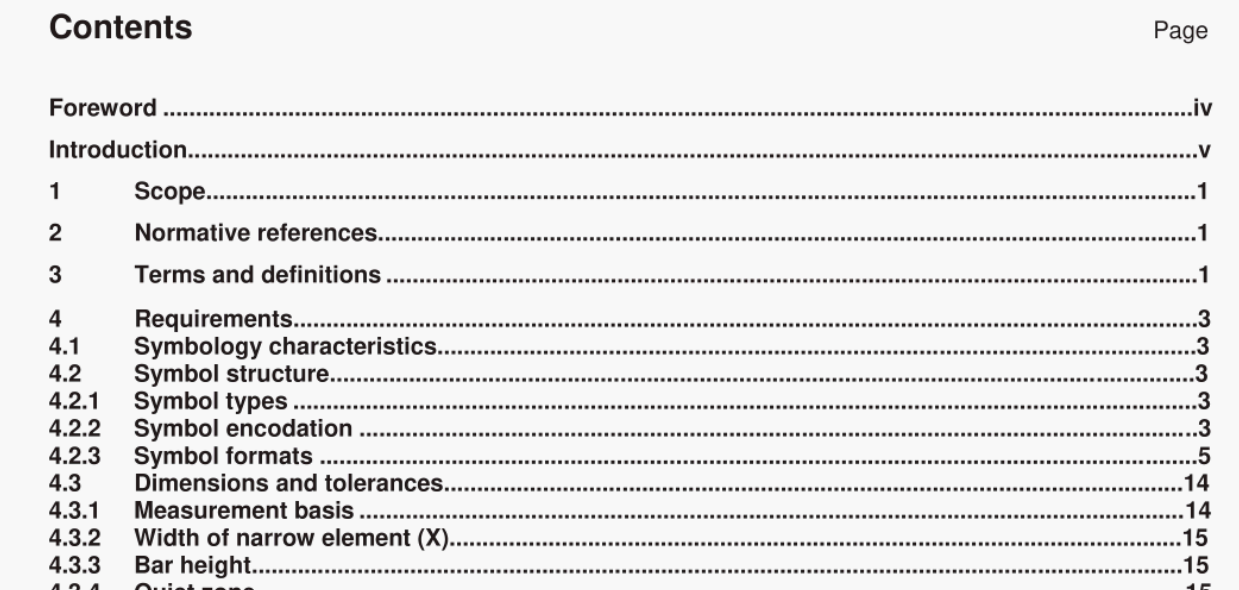BS ISO IEC 15420-2009 pdf Information technology一 Automatic identification and data capture techniques EAN/UPC bar code symbology specification

4.3.8 Magnification factors Symbols may be reduced or enlarged from the nominal size by applying a constant magnification factor in the range 0,8 to 2,0 to all dimensions. The magnification factor of the add-on symbol shall be the same as the magnification factor of the associated main symbol. Note: In applications defined by the GS1 General specifications, symbols may be reduced or enlarged from the nominal size by applying a constant magnification factor in the range 0,8 to 2,0 to all dimensions. Under the exceptional circumstances defined in the GS1 General Specifications, the range is extended to 0,75 to 2,0. When the magnification factor is reduced below 0,8 in these applications, the minimum quiet zones and bar height shall not be reduced below the dimensions applicable to a 0,8 magnification symbol. 4.3.9 Dimensional Tolerances The historical element tolerances shown in Annex F have been superseded by the test specifications in 4.5. 4.4 Reference decode algorithm Bar code reading systems are designed to read imperfect symbols to the extent that practical algorithms permit. This section describes the reference decode algorithm used to determine decode and decodability in symbol verification in accordance with 4.5. For each symbol character, let S equal the total measured width of the character. The value S is used to determine reference threshold (RT) values. Individual edge to similar edge measurements (e) are then compared to the Reference Threshold (RT) to determine E values. Character values are determined from E values and b values according to Table 10. Value e1 is defined as the measurement from the leading edge of a bar to the leading edge of the adjacent bar. Value e2 is defined as the measurement from the trailing edge of a bar to the trailing edge of the adjacent bar. The values b1 and b2 are the measurement from the leading edge of a bar to the trailing edge of the same bar.
- Previous:BS ISO IEC 19762.5-2008 pdf Information technology一 Automatic identification and data capture (AIDC) techniques - Harmonized vocabulary Part 5: Locating systems
- Next:BS IEC 62843-2013 pdf Standard for N times 64 kilobit per second optical fiber interfaces between teleprotection and multiplexer equipment
- ISO IEC 27050-4-2021 pdf Information technology — Electronic discovery — Part 4: Technical readiness
- ISO IEC 27036-1-2021 pdf Cybersecurity — Supplier relationships — Part 1: Overview and concepts
- ISO IEC 27013-2021 pdf Information security, cybersecurity and privacy protection — Guidance on the integrated implementation of ISO/IEC 27001 and ISO/IEC 20000-1
- ISO IEC 26580-2021 pdf Software and systems engineering — Methods and tools for the feature- based approach to software and systems product line engineering
- ISO IEC 24735-2021 pdf Information technology — Office equipment — Method for measuring digital copying productivity
- ISO IEC 24711-2021 pdf Information technology — Office equipment — Method for the determination of ink cartridge yield for colour inkjet printers and multi- function devices that contain printer components
- ISO IEC 23544-2021 pdf Information Technology — Data centres — Application Platform Energy Effectiveness (APEE)
- ISO IEC 23510-2021 pdf Information technology — 3D printing and scanning — Framework for an Additive Manufacturing Service Platform (AMSP)
- ISO IEC 23127-1-2021 pdf Information technology — Learning, education, and training — Metadata for facilitators of online learning — Part 1: Framework
- ISO IEC 23126-2021 pdf Information technology for learning, education and training — Ubiquitous learning resource organization and description framework
- IEC TR 63250-2021 pdf Household and similar electrical appliances – Method of measuring performance – Assessment of repeatability, reproducibility and uncertainty
- IEC 60836-2015 pdf Specifications for unused silicone insulating liquids for electrotechnical purposes
- ISO IEC 26580-2021 pdf Software and systems engineering — Methods and tools for the feature- based approach to software and systems product line engineering
- IEC 63002-2021 pdf Interoperability specifications and communication method for external power supplies used with computing and consumer electronics devices
- IEC 63171-2-2021 pdf Connectors for electrical and electronic equipment – Part 2: Detail specification for 2-way, shielded or unshielded, free and fixed connectors: mechanical mating information, pin assignment and additional requirements for type 2
- BS ISO IEC 15420-2009 pdf Information technology一 Automatic identification and data capture techniques EAN/UPC bar code symbology specification
- BS IEC 60860-2014 pdf Radiation protection instrumentation一 Warning equipment for criticality accidents
- BS ISO IEC 19762.5-2008 pdf Information technology一 Automatic identification and data capture (AIDC) techniques – Harmonized vocabulary Part 5: Locating systems
- ISO IEC 24711-2021 pdf Information technology — Office equipment — Method for the determination of ink cartridge yield for colour inkjet printers and multi- function devices that contain printer components
- ISO IEC 24735-2021 pdf Information technology — Office equipment — Method for measuring digital copying productivity